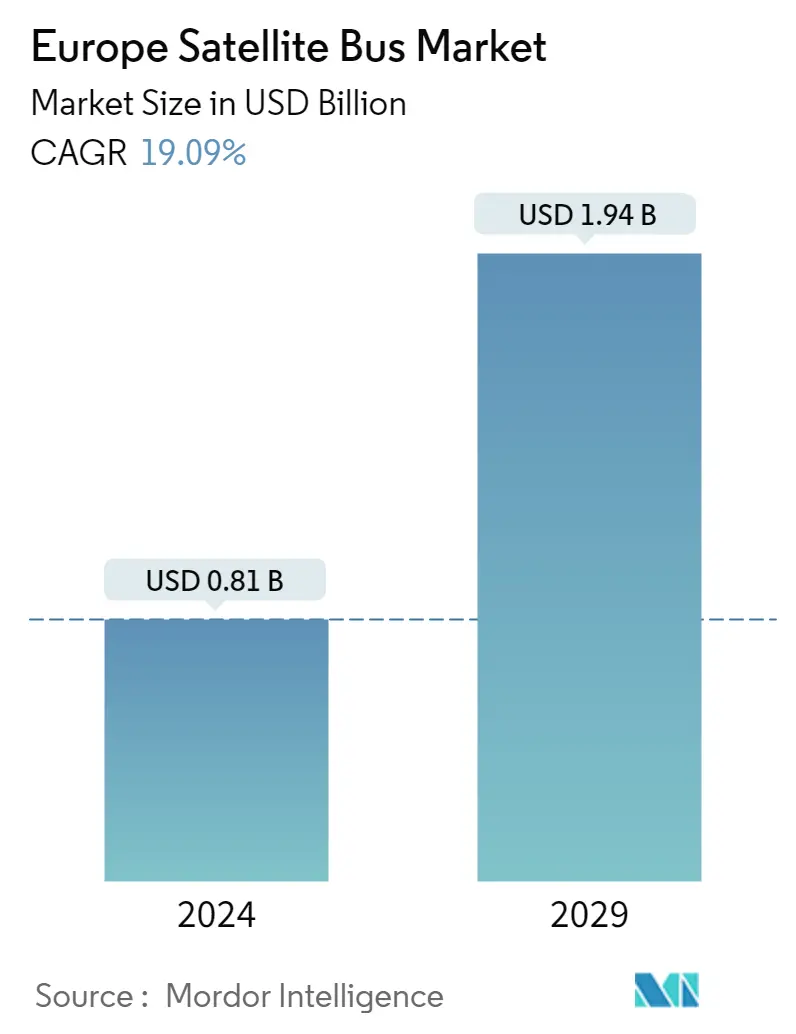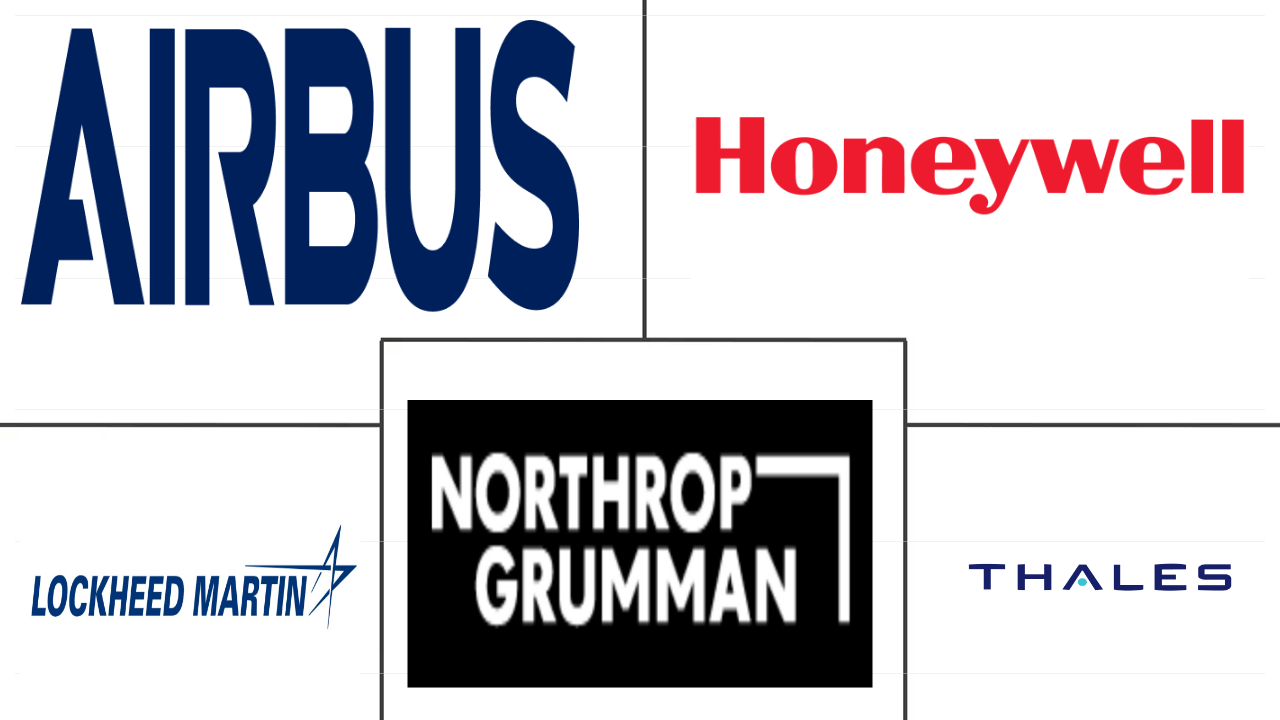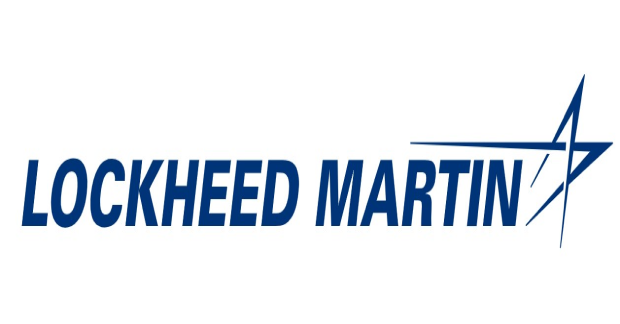Market Size of europe satellite bus Industry

| Icons | Lable | Value |
|---|---|---|
|
|
Study Period | 2017 - 2029 |
|
|
Market Size (2024) | USD 0.81 Billion |
|
|
Market Size (2029) | USD 1.94 Billion |
|
|
Largest Share by Orbit Class | LEO |
|
|
CAGR (2024 - 2029) | 19.09 % |
|
|
Largest Share by Country | United Kingdom |
|
|
Market Concentration | High |
Major Players |
||

|
||
|
*Disclaimer: Major Players sorted in no particular order |
Europe Satellite Bus Market Analysis
The Europe Satellite Bus Market size is estimated at USD 0.81 billion in 2024, and is expected to reach USD 1.94 billion by 2029, growing at a CAGR of 19.09% during the forecast period (2024-2029).
0.81 Billion
Market Size in 2024 (USD)
1.94 Billion
Market Size in 2029 (USD)
20.01 %
CAGR (2017-2023)
19.09 %
CAGR (2024-2029)
Largest Market by Satellite Mass
65.83 %
value share, 100-500kg, 2022
Minisatellites with expanded capacity for enterprise data (retail and banking), oil, gas, and mining, and governments in developed countries pose high demand. The demand for minisatellites with a LEO is increasing due to their expanded capacity.
Largest Market by Application
78.69 %
value share, Communication, 2022
Governments, space agencies, defense agencies, private defense contractors, and private space industry players are emphasizing the enhancement of the communication network capabilities for various public and military reconnaissance applications.
Largest Market by Orbit Class
72.49 %
value share, LEO, 2022
LEO satellites are increasingly being adopted in modern communication technologies. These satellites serve an important role in Earth observation applications.
Largest Market by End User
69.05 %
value share, Commercial, 2022
The commercial segment is expected to occupy a significant share because of the increasing use of satellites for various telecommunication services.
Leading Market Player
24 %
market share, Lockheed Martin Corporation, 2022

Lockheed Martin is the leading player in the Europe satellite bus market. It has a strong product portfolio and it's customers include civil and military customers. This has facilitated the company in capturing the highest share of the market.
Increasing launches of satellites into LEO orbit for various satellite applications is driving the market demand
- LEO satellites are used for various applications, including weather monitoring, Earth observation, and remote sensing. In Europe, satellite buses such as the SSTL-150 bus developed by Surrey Satellite Technology Limited (SSTL) are used for LEO satellites. The SSTL-150 bus is a versatile platform that can support a range of payloads, including cameras, AIS (Automatic Identification System) receivers, and small satellites. Between 2017 and 2022, approximately 531 satellites were launched into LEO.
- GEO satellites are used for applications such as satellite-based television broadcasting, weather forecasting, and military communication systems. European satellite manufacturers use bus designs such as the Spacebus NEO developed by Thales Alenia Space for GEO satellites. The Spacebus NEO is a highly capable platform that can support a wide range of payloads, including large television broadcasting antennas and high-power amplifiers. Between 2017 and 2022, approximately 16 satellites were launched into GEO.
- MEO satellites are used for global navigation systems (GNSS) such as GPS and Galileo and satellite-based broadband services. European satellite manufacturers use a variety of bus designs for MEO applications, including the Eurostar E3000 bus developed by Airbus Defense and Space. The Eurostar E3000 bus is a reliable platform that has been used for numerous MEO applications. The standardized platform of the bus enables satellite manufacturers to build a range of MEO satellites for different applications with a high degree of reliability and cost-effectiveness. Between 2017 and 2022, approximately 16 satellites were launched into MEO. And the overall market is expected to grow by 19.43% during 2023-2029.
Europe Satellite Bus Industry Segmentation
Communication, Earth Observation, Navigation, Space Observation, Others are covered as segments by Application. 10-100kg, 100-500kg, 500-1000kg, Below 10 Kg, above 1000kg are covered as segments by Satellite Mass. GEO, LEO, MEO are covered as segments by Orbit Class. Commercial, Military & Government are covered as segments by End User.
- LEO satellites are used for various applications, including weather monitoring, Earth observation, and remote sensing. In Europe, satellite buses such as the SSTL-150 bus developed by Surrey Satellite Technology Limited (SSTL) are used for LEO satellites. The SSTL-150 bus is a versatile platform that can support a range of payloads, including cameras, AIS (Automatic Identification System) receivers, and small satellites. Between 2017 and 2022, approximately 531 satellites were launched into LEO.
- GEO satellites are used for applications such as satellite-based television broadcasting, weather forecasting, and military communication systems. European satellite manufacturers use bus designs such as the Spacebus NEO developed by Thales Alenia Space for GEO satellites. The Spacebus NEO is a highly capable platform that can support a wide range of payloads, including large television broadcasting antennas and high-power amplifiers. Between 2017 and 2022, approximately 16 satellites were launched into GEO.
- MEO satellites are used for global navigation systems (GNSS) such as GPS and Galileo and satellite-based broadband services. European satellite manufacturers use a variety of bus designs for MEO applications, including the Eurostar E3000 bus developed by Airbus Defense and Space. The Eurostar E3000 bus is a reliable platform that has been used for numerous MEO applications. The standardized platform of the bus enables satellite manufacturers to build a range of MEO satellites for different applications with a high degree of reliability and cost-effectiveness. Between 2017 and 2022, approximately 16 satellites were launched into MEO. And the overall market is expected to grow by 19.43% during 2023-2029.
| Application | |
| Communication | |
| Earth Observation | |
| Navigation | |
| Space Observation | |
| Others |
| Satellite Mass | |
| 10-100kg | |
| 100-500kg | |
| 500-1000kg | |
| Below 10 Kg | |
| above 1000kg |
| Orbit Class | |
| GEO | |
| LEO | |
| MEO |
| End User | |
| Commercial | |
| Military & Government | |
| Other |
Europe Satellite Bus Market Size Summary
The Europe Satellite Bus Market is poised for significant growth, driven by the increasing demand for satellite applications across various sectors. The market is characterized by the development and deployment of satellite buses for Low Earth Orbit (LEO), Geostationary Orbit (GEO), and Medium Earth Orbit (MEO) satellites. European manufacturers, such as Surrey Satellite Technology Limited and Thales Alenia Space, are at the forefront, providing versatile platforms like the SSTL-150 and Spacebus NEO, respectively. These platforms support a wide range of payloads, catering to applications such as weather monitoring, Earth observation, and satellite-based communication. The trend towards smaller satellites is gaining momentum, attributed to their cost-effectiveness and shorter development cycles, which align with the region's strategic focus on innovation and technological advancement.
The market landscape is fairly consolidated, with major players like Airbus SE, Honeywell International Inc., Lockheed Martin Corporation, Northrop Grumman Corporation, and Thales dominating the scene. The European Space Agency's increased funding proposals and national investments from countries like France and Germany underscore the region's commitment to enhancing its capabilities in satellite bus manufacturing and space exploration. This financial backing is expected to bolster the development of satellite buses, particularly for smaller satellites, as Europe aims to maintain its competitive edge in the global space industry. The market's expansion is further supported by the robust framework for designing and manufacturing satellites, which is anticipated to meet the growing demands from civil, commercial, and military sectors in the coming years.
Europe Satellite Bus Market Size - Table of Contents
-
1. MARKET SEGMENTATION (includes market size in Value in USD, Forecasts up to 2029 and analysis of growth prospects)
-
1.1 Application
-
1.1.1 Communication
-
1.1.2 Earth Observation
-
1.1.3 Navigation
-
1.1.4 Space Observation
-
1.1.5 Others
-
-
1.2 Satellite Mass
-
1.2.1 10-100kg
-
1.2.2 100-500kg
-
1.2.3 500-1000kg
-
1.2.4 Below 10 Kg
-
1.2.5 above 1000kg
-
-
1.3 Orbit Class
-
1.3.1 GEO
-
1.3.2 LEO
-
1.3.3 MEO
-
-
1.4 End User
-
1.4.1 Commercial
-
1.4.2 Military & Government
-
1.4.3 Other
-
-
Europe Satellite Bus Market Size FAQs
How big is the Europe Satellite Bus Market?
The Europe Satellite Bus Market size is expected to reach USD 0.81 billion in 2024 and grow at a CAGR of 19.09% to reach USD 1.94 billion by 2029.
What is the current Europe Satellite Bus Market size?
In 2024, the Europe Satellite Bus Market size is expected to reach USD 0.81 billion.

